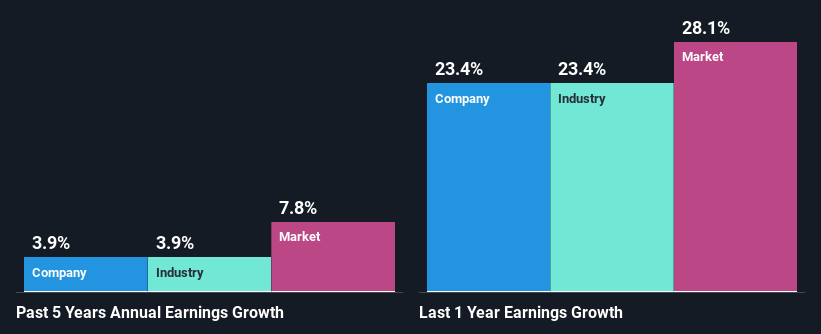Is Port of Tauranga Limited's (NZSE:POT) Stock On A Downtrend As A Result Of Its Poor Financials?
With its stock down 7.3% over the past three months, it is easy to disregard Port of Tauranga (NZSE:POT). Given that stock prices are usually driven by a company’s fundamentals over the long term, which in this case look pretty weak, we decided to study the company's key financial indicators. In this article, we decided to focus on Port of Tauranga's ROE.
ROE or return on equity is a useful tool to assess how effectively a company can generate returns on the investment it received from its shareholders. In other words, it is a profitability ratio which measures the rate of return on the capital provided by the company's shareholders.
Check out our latest analysis for Port of Tauranga
How Do You Calculate Return On Equity?
The formula for return on equity is:
Return on Equity = Net Profit (from continuing operations) ÷ Shareholders' Equity
So, based on the above formula, the ROE for Port of Tauranga is:
7.8% = NZ$110m ÷ NZ$1.4b (Based on the trailing twelve months to December 2021).
The 'return' refers to a company's earnings over the last year. So, this means that for every NZ$1 of its shareholder's investments, the company generates a profit of NZ$0.08.
What Is The Relationship Between ROE And Earnings Growth?
Thus far, we have learned that ROE measures how efficiently a company is generating its profits. Based on how much of its profits the company chooses to reinvest or "retain", we are then able to evaluate a company's future ability to generate profits. Generally speaking, other things being equal, firms with a high return on equity and profit retention, have a higher growth rate than firms that don’t share these attributes.
A Side By Side comparison of Port of Tauranga's Earnings Growth And 7.8% ROE
At first glance, Port of Tauranga's ROE doesn't look very promising. However, its ROE is similar to the industry average of 7.8%, so we won't completely dismiss the company. We can see that Port of Tauranga has grown at a five year net income growth average rate of 3.9%, which is a bit on the lower side. Bear in mind, the company's ROE is not very high . So this could also be one of the reasons behind the company's low growth in earnings.
Next, on comparing Port of Tauranga's net income growth with the industry, we found that the company's reported growth is similar to the industry average growth rate of 3.9% in the same period.
Earnings growth is a huge factor in stock valuation. It’s important for an investor to know whether the market has priced in the company's expected earnings growth (or decline). Doing so will help them establish if the stock's future looks promising or ominous. If you're wondering about Port of Tauranga's's valuation, check out this gauge of its price-to-earnings ratio, as compared to its industry.
Is Port of Tauranga Using Its Retained Earnings Effectively?
Port of Tauranga has a three-year median payout ratio of 90% (implying that it keeps only 9.8% of its profits), meaning that it pays out most of its profits to shareholders as dividends, and as a result, the company has seen low earnings growth.
Additionally, Port of Tauranga has paid dividends over a period of at least ten years, which means that the company's management is determined to pay dividends even if it means little to no earnings growth. Upon studying the latest analysts' consensus data, we found that the company is expected to keep paying out approximately 90% of its profits over the next three years. Accordingly, forecasts suggest that Port of Tauranga's future ROE will be 8.4% which is again, similar to the current ROE.
Summary
On the whole, Port of Tauranga's performance is quite a big let-down. While the company has posted decent earnings growth, the company is retaining little to no profits and is reinvesting those profits at a low rate of return. This makes us doubtful if that growth could continue, especially if by any chance the business is faced with any sort of risk. We also studied the latest analyst forecasts and found that the company's earnings growth is expected be similar to its current growth rate. To know more about the company's future earnings growth forecasts take a look at this free report on analyst forecasts for the company to find out more.
Have feedback on this article? Concerned about the content? Get in touch with us directly. Alternatively, email editorial-team (at) simplywallst.com.
This article by Simply Wall St is general in nature. We provide commentary based on historical data and analyst forecasts only using an unbiased methodology and our articles are not intended to be financial advice. It does not constitute a recommendation to buy or sell any stock, and does not take account of your objectives, or your financial situation. We aim to bring you long-term focused analysis driven by fundamental data. Note that our analysis may not factor in the latest price-sensitive company announcements or qualitative material. Simply Wall St has no position in any stocks mentioned.

 Yahoo Finance
Yahoo Finance 
